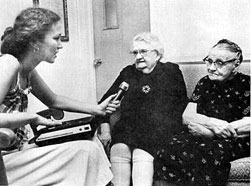The Greater Cleveland Ethnographic Museum Collection
The Immigrant Experience Project

Wiebel Van der Muelen interviews Lena Moso and Magareta Meister (Press photo by Bernie Noble)
The Greater Cleveland Ethnographic Museum embarked on several research projects investigating the cultural history of Cleveland. One of the first was the Immigrant Experience Project, an oral history project which goal was to capture the experience of immigrants who settled in Cleveland between 1900 and 1930 (see Project Summary). The museum recorded the stories of approximately ninety immigrants from over thirty cultural backgrounds.
Participants were asked about why and how they immigrated to Cleveland, what life was like in the Old country, and how they had adjusted to life in Cleveland. The founders of the museum recognized that the immigrant experience was common to many Clevelanders and the museum sought to preserve their stories in order to foster understanding and better intergroup relations in the community.
Most of the interviews were conducted in English but through funding provided by the Ohio Arts Council, the Greater Cleveland Ethnographic Museum was able to hire two college interns in the summer of 1978 to interview people for in the Jewish and German communities. They translated the interviews in German and Yiddish to English for the museum. To read some of their transcriptions, please see the Project Internship Report.
Once these oral histories were recorded and background research was completed, the museum created an exhibit called Passages to American Life which presented what life in Cleveland was like for immigrants arriving between 1900 and 1935. Given the grassroots nature of the museum, they borrowed many items for their exhibit to make it possible. The focus of the exhibit was to show what everyday life was like for individuals as they married, started a family, and became active in community life through their ethnic church or social, cultural, fraternal, or political organizations. Also displayed in the exhibit were photographs, writings, and objects that were collected from the interviewees that participated in the project and cultural instituions in Cleveland. The exhibit was mounted at the Greater Cleveland Ethnographic Museum in the Arcade until April 20, 1979 when it traveled to Cleveland State University (CSU), showing until June 15, 1979.
Five of these oral history transcriptions are included for view: George Janas, a Greek immigrant; Mrs. Latify Shibley, an immigrant from Lebanon; Libby Malkin, a Jewish woman from the Ukraine; Italian-American woman, Mrs. Clara Grillo; and Romanian immigrant, Sarah Goodman. The Greater Cleveland Ethnographic Museum embarked on several research projects investigating the cultural history of Cleveland. One of the first was the Immigrant Experience Project, an oral history project which goal was to capture the experience of immigrants who settled in Cleveland between 1900 and 1930 (see Project Summary). The museum recorded the stories of approximately ninety immigrants from over thirty cultural backgrounds. Participants were asked about why and how they immigrated to Cleveland, what life was like in the Old country, and how they had adjusted to life in Cleveland. The founders of the museum recognized that the immigrant experience was common to many Clevelanders and the museum sought to preserve their stories in order to foster understanding and better intergroup relations in the community.



